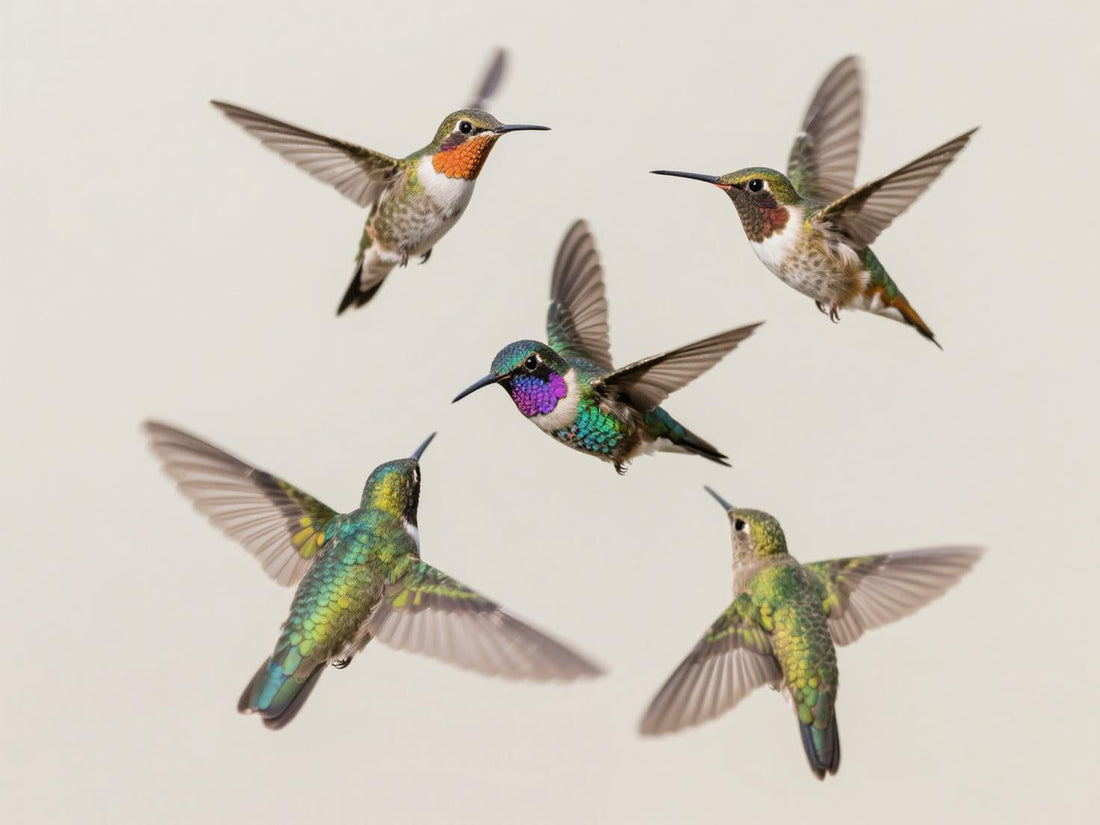Hummingbirds —— Nature's Miniature Wonders
TaylorAlice
Among the flowers of the American continent, there lives a group of "hovering" fairies. Adorned with rainbow colors and flapping their wings like the wind at a frequency of 80 times per second, they seem to be frozen in mid-air as if by magic - these are hummingbirds, one of the smallest birds in the world, yet they hold the most astonishing life codes.
The Unique Skills of the Flight Master
The wing structure of hummingbirds is a black technology in nature. Their shoulder joints can rotate freely, and the "8" shaped trajectory of their wings enables them to be the only birds capable of flying backward and hovering. This flight mode is extremely energy-consuming; hummingbirds need to consume nectar equivalent to 1.5 times their body weight every day (approximately equal to a human drinking 100 cans of cola daily).
To save energy, they have even evolved an "air brake" skill - when in danger, they can stop from high-speed flight within 0.1 seconds.

Wisdom Secrets for Survival in the Flower Garden
Master of Precise Memory
Hummingbirds possess an extraordinary spatial memory, capable of remembering the blooming time and location of every flower within a five-kilometer radius. Experiments have shown that they can remember the location of artificial feeders for over half a year and even distinguish the sugar concentration of different feeders, preferring the "golden sweetness" of 25%.
Expert in Temperature Regulation
When the temperature drops sharply at night, hummingbirds enter a "hibernation state": their body temperature drops from 40°C to 18°C, and their heart rate plummets from 1,200 beats per minute to 50 beats per minute, as if switching to "power-saving mode". This ability enables them to survive cold spring nights and fully recover the next day when the sun rises.
Battle Mode
Despite their small size (the smallest species weighs only 2 grams), hummingbirds have a strong sense of territory. Males mark out a 10-meter diameter "air territory" and use dive attacks to drive away intruders. During a dive, they can reach speeds of up to 100 kilometers per hour, and the whistling sound produced during the dive can also intimidate opponents.

Breeding Season
Courtship
Male hummingbirds are the "acrobats" of the bird world. During courtship, they fly up to 20 meters high and dive at a speed of 60 times per second, drawing a U-shaped trajectory in front of the female, with their tail feathers vibrating to produce a buzzing sound like that of a bee. Some species also spread their tail feathers, displaying a rainbow-like sheen like a peacock spreading its tail.
The Pocket-sized Architect
The female bird weaves a walnut-sized nest using spider silk, lichen and plant fibers. The elasticity of the spider silk allows the nest to expand as the chicks grow. Moss is often used to cover the outside of the nest for camouflage, and the inside is lined with dandelion fluff to create a "mattress". It takes 5 to 7 days to build the nest, during which the female bird repeatedly tests its load-bearing capacity to ensure it can withstand wind and rain.
Feeding the chicks
The hummingbird mother feeds her chicks over a hundred times a day, bringing back nectar and insects every 15 to 20 minutes. Five days after hatching, the chicks' appetite surges, and the mother has to forage around the clock, even venturing to snatch nectar from other hummingbirds' territories. After 20 days, the young birds can leave the nest, but they still need to learn survival skills such as precise hovering and nectar gathering.
Cold Knowledge You May Not Know
Language Communication Expert
Hummingbirds not only make "chirping" sounds but can also "speak" through the vibration of their wings. Male hummingbirds use high-frequency wing flapping sounds to declare their territory, while females respond to courtship with specific rhythmic chirps. Some species can even imitate the buzzing of insects to deceive predators.
The Mystery of Migration Routes
When migrating, North American hummingbirds follow the "coastline rule": they head north along the Pacific coast in spring but choose the inland mountains for their return journey in autumn. Scientists have discovered that they can sense changes in the Earth's magnetic field and use the position of the setting sun to calibrate their direction. The red-throated hummingbird, weighing only 5 grams, migrates a round trip of 8,000 kilometers each year, which is equivalent to a human running around the Earth's equator 20 times without rest.
The Magic of Feathers
The feathers of hummingbirds lack pigments. Their metallic luster comes from the nanostructures on the surface of the feathers. After light passes through multiple layers of refraction, it presents iridescent colors like sapphire and emerald. The Mayans once used these "structural color" feathers to make sacrificial garments. Modern scientists have drawn inspiration from this to develop environmentally friendly fibers that do not require dyes.
The Code of Coexistence with Humans
In American courtyards, hanging red feeders (with a sugar-to-water ratio of 4:1) has become a ritual to welcome hummingbirds. But true protection lies in ecological restoration: planting nectar-rich plants such as sage and penstemon to create "aerial dining halls" for them. Research has found that the beaks of urban hummingbirds are 3% shorter than those of their wild counterparts, which might be an evolutionary adaptation to artificial feeders.
